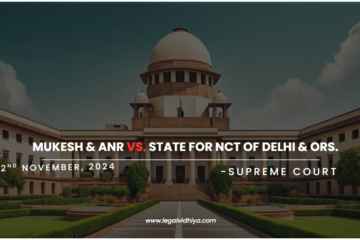
M/S. Kone Elevator India Pvt. Ltd v. State of Tamil Nadu. & Ors.
BRIEF FACTS OF THE CASE
In this case, the appellants are a company operating in the elevator and escalator industry. They specialize in providing innovative and eco-efficient solutions for elevators, escalators, and automatic building doors.
The appellants were responsible for delivering the elevators in a knocked-down state and assembling them on-site.
The customer had a contractual obligation to prepare the site by performing civil works for the lift pit and hoistway, as well as arranging for power supply.
The installation obligations of the appellants included mechanical erection, electrical wiring, testing, and commissioning of the lift, which would commence upon prior intimation from the customer that the site was ready.
ISSUES RAISED BEFORE THE COURT
Whether a contract for manufacture, supply, and installation of lifts is a contract of sale or a works contract?
Definition of Contract of Sale and Works Contract.
A CONTRACT OF SALE is defined under the Sale of Goods Act, 1930. It refers to an agreement between parties where one party (seller) agrees to transfer the ownership of goods to another party (buyer) in exchange for a price. The essential elements of a contract of sale include an agreement to sell, transfer of ownership, and payment of price.
A WORKS CONTRACT is defined under the Goods and Services Tax (GST) Act, 2017. It refers to a contract where the transfer of property in goods is involved, but it also includes the provision of services for the execution of a work. A works contract is a combination of both goods and services.
View:
The installation obligation in a contract for manufacture, supply, and installation of lifts is not merely incidental but is a profound and integral part of the contract. Therefore, such a contract should be considered a works contract rather than a contract of sale.
CONTENTION
Argument from Appellants Side.
The appellants have put forth several key contentions in this case.
Firstly, they have referred to the Bombay Lifts Act, 1939, the Bombay Lifts Rules, 1958, and the Bombay Lifts (Amendment) Rules, 2010.
They have specifically drawn attention to the definitions provided in clause 3 (c) of these rules. According to these definitions, a “lift” is defined as a hoisting mechanism equipped with a car that moves in a substantially vertical direction, powered by a power source, and designed to carry passengers or goods, or both.
Additionally, a “lift installation” includes not only the lift car, but also the lift way, the lift way enclosure, and the operating mechanism of the lift. It encompasses all ropes, cables, wires, and equipment directly connected to the operation of the lift.
Based on these definitions, the appellants argue that the legal framework recognizes the lift installation as a distinct entity, comprising various components and mechanisms that are integral to its functioning. They contend that this supports their claim that the supply and installation of a lift should be treated as a composite contract involving both goods and services.
Furthermore, the appellants have also placed reliance on specific sections of the Bombay Lifts Act. They refer to Section 4, which deals with obtaining permission to erect a lift, Section 5, which pertains to obtaining a license to use a lift, and Section 7, which states that a lift cannot be operated without a license. By highlighting these sections, the appellants aim to emphasize the regulatory control imposed by the statutory provisions on the manufacture, supply, and installation of lifts. They argue that these provisions reflect the need for immense skill in the installation process. They assert that the separate parts of a lift are not sold individually as goods, but rather, the lift only becomes operational after it is installed, adjusted, tested, and commissioned in a building.
In simple words, the appellants argued that the contract for the manufacture, supply, and installation of lifts should be considered a works contract. They relied on previous decisions that supported this view and emphasized the integral nature of the installation obligation.
Argument from Respondents Side.
The Revenue, represented by Mr. R. Venkataramani, has presented several key contentions in this case.
Firstly, they argue that a lift should be considered as a complete system, where the work of installation is merely fulfilling the process of erecting and making it functional. They assert that the installation is not a separate service, but rather an integral part of bringing the lift to its usable state.
Furthermore, the Revenue contends that the act of installation should be seen as the culmination of the sale of the lift. They argue that once the lift is sold, the installation process is necessary to make it usable, and therefore, it should be considered as part of the sale transaction.
The Revenue also emphasizes that a lift or elevator is an identifiable good that is transferred to the purchaser. They acknowledge that a certain amount of labor is required to bring the lift to its usable state, but they argue that this labor should not be regarded as a separate works contract. Instead, they assert that it is an inherent part of the sale of the lift itself.
In summary, the Revenue’s key contentions are that the installation of a lift should be seen as fulfilling the process of making it functional, that it is the culmination of the sale, and that the labor involved in the installation should not be considered as a separate works contract.
In simple words, the respondents contended that the contract should be treated as a contract of sale, subject to sales tax. They relied on a previous Supreme Court judgment that had taken this view.
RATIONALE & JUDGEMENT
The Supreme Court, after careful consideration of the arguments and previous judgments, rendered its decision in the case regarding the classification of a contract for the manufacture, supply, and installation of lifts.
The Court held that the installation obligation in a contract for lift manufacture, supply, and installation is not merely incidental but is a profound and integral part of the contract.
They emphasized that the installation aspect cannot be separated from the overall purpose and essence of the contract. Therefore, the Court concluded that such a contract should be treated as a works contract rather than a contract of sale.
In reaching this conclusion, the Court overruled a previous judgment that had taken a contrary view. The Court found that the previous judgment did not adequately consider the significance of the installation obligation and its integral role in the contract.
The Court’s decision has significant implications for the taxation of similar contracts under sales tax laws. By classifying the contract as a works contract, the Court clarified that the entire value of the consideration cannot be taxed under the sales tax law. This ruling provides clarity and guidance for future cases involving contracts of this nature.
Overall, the Supreme Court’s judgment establishes that a contract for the manufacture, supply, and installation of lifts should be considered a works contract, recognizing the importance of the installation obligation in such contracts.
RULING OF THE COURT
In this case, the Hon’ble Supreme Court, through a majority view of the Constitution Bench, has overturned the previous judgment.
They have now ruled that a composite contract for the supply and installation of lifts should be considered a works contract rather than a simple sale of goods or chattel.
This means that the contract is not solely focused on the transfer of goods, but also encompasses the provision of services for the installation of the lifts.
CONCLUSION
In this case, the Hon’ble Supreme Court held that a contract for the manufacture, supply, and installation of lifts should be considered a works contract. This decision has significant implications for the taxation of such contracts under sales tax laws.
REFERENCES
https://www.advocatekhoj.com/library/judgments/announcement.php?WID=15342
Case Analysis by Himadri Basu, LL.B Final Year Student from Gauhati University.




0 Comments